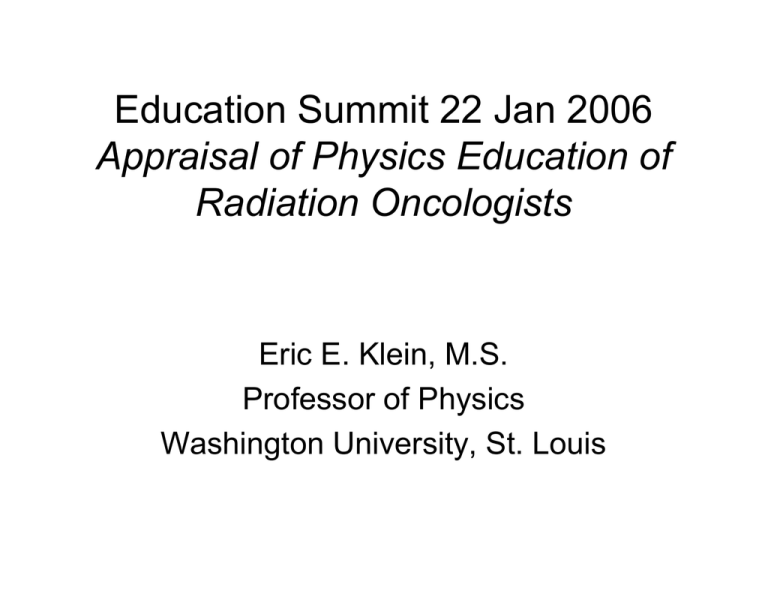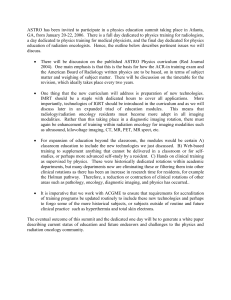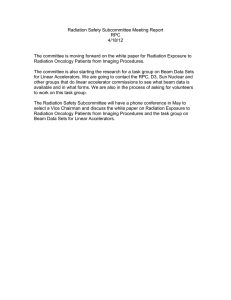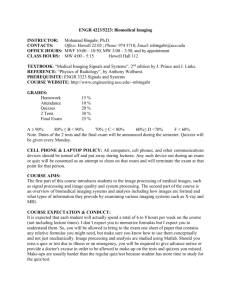Education Summit 22 Jan 2006 Appraisal of Physics Education of Radiation Oncologists
advertisement

Education Summit 22 Jan 2006 Appraisal of Physics Education of Radiation Oncologists Eric E. Klein, M.S. Professor of Physics Washington University, St. Louis 2001 Question of What Drives What? • Driving Forces: – Physician Career Needs Should Obviously Mandate Curriculum, ……but – Residents Need to Pass ABR Writtens – Facilities Use the ACR In-Training Exam as a Gauge of Success for the Early Resident • What Completes the Cycle? – Is the ABR Exam Current for Current Career Subjects? – Is the ACR Exam Geared for Career Needs or the ABR Exam? – Is Raphex the Go-Between? What was happening in the late 90s AAPM’s Training of Radiologists Committee of the Education Council Conducted Survey of Training Programs (Klein et al, IJORBP, 1996) Most taught exclusively to PGY2. Some taught different subjects (or levels) to different year residents. Radiation dosimetry, treatment planning, and brachytherapy constituted ~ half of the teaching hours. On average total classroom time was 61.4 hours/year with a range of 24-118 hours. Khan’s textbook was the most prevalent resource for most subjects. The survey results reveal enormous differences in national teaching efforts. Goal of ASTRO’s Core Physics Curriculum for Radiation Oncology Residents • Make Recommendation to, first and foremost, Teaching Programs as to Curriculum Based on Career Needs • In addition, ABR and ACR to use Recommendations to Update Exams • Further Recommendations as to Teaching Modalities: Move to Web-based Aids ASTRO’s Core Physics Curriculum for Radiation Oncology Residents ASTRO Ad-hoc Committee • Eric E. Klein, M.S., Chair - Washington University • James M. Balter, Ph.D. - University of Michigan, • Edward L. Chaney, Ph.D. - University of North Carolina (now replaced by Bhudatt Paliwal) • Bruce J. Gerbi, Ph.D. - University of Minnesota • Lesley Hughes, M.D. - Drexel University RESULTING DOCUMENT • The document resulted in a recommended 54-hour course. • Some of the subjects were based on American College of Graduate Medical Education (ACGME) requirements (particles, hyperthermia). • Majority of the subjects along with the appropriated hours per subject were devised and agree upon by the committee. Subject Matter (*Indicates Subject Matter that should be Complemented During a Physics Rotation.) Teaching Hours /Subject Atomic and Nuclear Structure (including decay and Radioactivity) Production of X-rays, photons and electrons 3 Radiation Interactions 3 Treatment Machines and Generators; Simulators (incl. CT) Radiation Beam Quality and Dose 3 Radiation Measurement and Calibration 4* Photons (incl. concepts, isodoses, MU, heterogeneities, field shaping, compensation, field matching, etc.) 7* Electrons (incl. concepts, isodoses, MU, heterogeneities, field shaping, field matching, etc.) 3* External Beam Quality Assurance 2* 2 2 Radiation Protection and Shielding 2 Imaging for Radiation Oncology 4 3DCRT including ICRU concepts and beam related biology Assessment of Patient Setup and Treatment (incl. EPID, Immobilization, etc.) 3* IMRT 2* Special Procedures (incl. Radiosurgery, TBI, etc.) 3* Brachytherapy (incl. Intracavitary, Interstitial, HDR, etc.) Hyperthermia 7* Particle Therapy 1 Total 2* 1 54 RESULTING DOCUMENT • For each subject there are learning objectives and for each hour there is a detailed outline of material to be covered. • Some of the required subjects/hours are being taught in most institutions (i.e., Radiation Measurement and Calibration for 4 hours), while some may be new subjects (4 hours of Imaging for Radiation Oncology). 4. Treatment Machines and Generators; Simulators (3 Lectures) Learning Objectives The resident should learn about: 1) the mechanics and delivery of radiation with respect to wave guides, magnetron v. klystron for production 2) the production and delivery of electrons by the electron gun, buncher, and scattering foil v. scanning 3) the use in photon and electron delivery 4) benefits and limitations of MLC collimators and cerrobend and hand-block 5) the production and collimation of superficial photons 6) the production of low energy x-rays for imaging 7) the differences in film and other imaging modalities for simulation, the DRR (digitally reconstructed radiograph) production and use 3 LECTURES FOR Treatment Machines and Simulators A. Linear accelerators - Operational theory of wave guides - Bending magnet systems Photon beam Delivery Electron beam delivery - Beam energy - Monitor chamber B. Linac Collimation systems and other Teletherapy - Primary and secondary collimators - Multileaf collimators - Other collimation systems - Radiation and light fields (including field size definition) - Cobalt units - Therapeutic x-ray (<300 kVp) C. Simulators Mechanical and Radiographic Operation Fluoroscopy and Intensifiers CT Simulation Machinery and Operation Imaging for Radiation Oncology Learning Objectives - The resident should learn: 1) the physical principles associated with good diagnostic imaging techniques. 2) the rational behind taking port films, how port films are used in the clinic, and the response characteristics of common films used in the radiation therapy department. 3) the types of portal imaging devices that are available in radiation therapy, the operating characteristics of these various devices, and the clinical application of this technology in daily practice. 4) the physical principles of ultrasound, its utility and limitations as an imaging device, and its application to diagnosis and patient positioning. 5) the physical principles behind CT, MR, and PET scanning, how these modalities are applied to treatment planning, and their limitations. 6) the advantages of one imaging modality over another for various disease and body sites. 7) image fusion, its advantage in treatment planning, the difficulties and limitations associated with image fusion, and how image fusion can be accomplished. 4 Lectures for Imaging for Radiation Oncology A. Routine Imaging - Diagnostic Imaging Physical principles - Port Films - XV-2 film, EDR-2 film characteristics - Processors B. Other Imaging 1. Electronic Portal Imaging - Overview of electronic portal imaging devices - Types of portal imaging devices - Clinical applications of EPID technology in daily practice 2. Ultrasound - Physical principles - Utility in diagnosis and patient positioning 4 Lectures for Imaging for Radiation Oncology (cont.) C. Image Based Treatment Planning 1. CT scans Physical principles Hounsfield Units, CT numbers, inhomogeneity corrections based on CT scan images 2. MRI Scanning Physical principles T1, T2, TE, TR imaging characteristics Advantages & limitations of MRI images for diagnosis and computerized treatment planning D. PET Imaging 1. Physical principles 2. Utility for Radiation Therapy 3. Image Fusion - Advantages, Challenges, Techniques, Limitations SUMMARY • To ensure that the subject matter and emphasis remain current and relevant, the curriculum will be updated every two years. – For example, specific IGRT courses may replace some classical physics • Committee is looking at recommendations for on-line supplemental learning • Committee hasn’t commit on references or specifics on when to teach (1st vs. 2nd vs. 3rd vs. 4th) or frequency (i.e., 1st and 3rd vs. 2nd and 4th) • Reference: Klein EE, Balter JM, Chaney EL, Gerbi BJ, Hughes L. ASTRO’s Core Physics Curriculum for Radiation Oncology Residents. Int J Radiat Oncol Biol Phys. 2004 Nov 1;60(3):697-705. New Curriculum • Reduced some classical courses (Atomic Structure, Electrons, General Brachy • Increase in IMRT (2 to 4), Radiopharm (2) Challenges to Training • Preparation for new technologies. • IMRT should be a staple with dedicated hours to cover all applications. Technologies of IGRT should be introduced in the curriculum. • Radiology/radiation oncology residents must become more adept in all imaging modalities. • Rather than this taking place in a diagnostic imaging rotation, there must again be enhancement of training within radiation oncology for imaging modalities such as ultrasound, kilovoltage imaging, CT, MR, PET, MR spect, etc. New Modules for Training For expansion of education beyond the classroom, the modules would be: • A) classroom education to include the new technologies we just discussed. • B) Web-based training to supplement anything that cannot be delivered in a classroom or for self-studies, or perhaps more advanced self-study by a resident. • C) Hands on clinical training as supervised by physics. These were historically dedicated rotations within academic departments, but many departments now are eliminating these or filtering them into other clinical rotations as there has been an increase in research time for residents, for example the Holman pathway. Therefore, a reduction or contraction of clinical rotations of other areas such as pathology, oncology, diagnostic imaging, and physics has occurred. ACGME (Reviews Programs) It is imperative that we work with ACGME to ensure that requirements for accreditation of training programs be updated routinely to include these new technologies and perhaps to forgo some of the more historical subjects, or subjects outside of routine and future clinical practice such as hyperthermia and total skin electrons.



